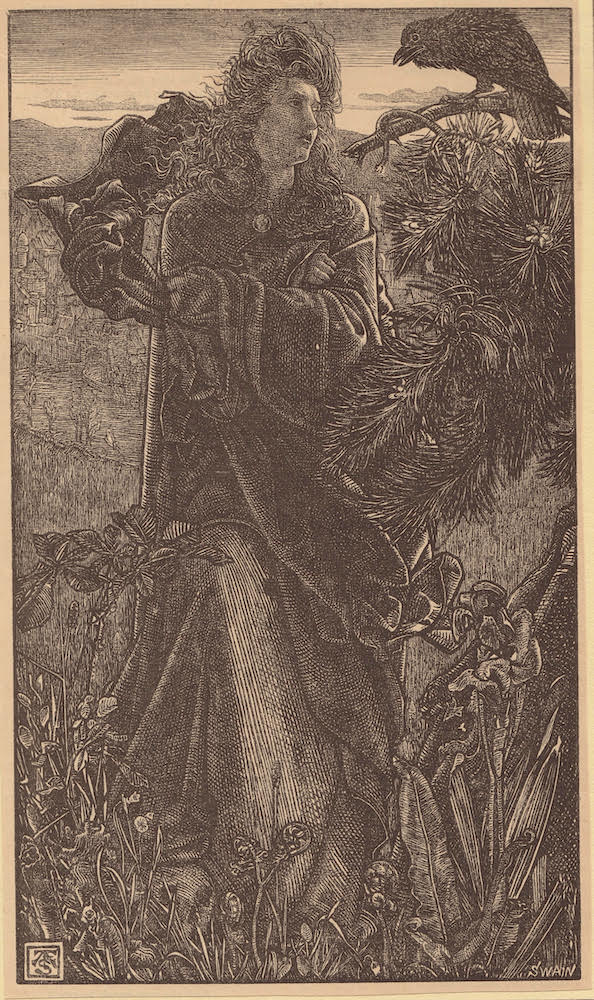

Harald Harfagr [Valkyrie]. 1862. Left: compositional sketch. Pencil on off-white paper. 8 x 5 5/16 inches (20.2 x 13.5 cm) – sheet size. Collection of Scottish National Gallery of Modern Art, Edinburgh, accession no. D 3710. Image courtesy of the National Gallery of Scotland. Right: Wood engraving by Joseph Swain in black ink on cream paper. 7 1/4 x 4 1/4 inches (18.5 x 10.8 cm) – image size. Private collection, image courtesy of the author.
No finished compositional sketch for this illustration in brush and black ink is known to exist but photographs of the drawing on the wood block do survive. The print shows the figure of a Valkyrie, with her head half to the right, standing on a hillside with her hair and her scarf billowing behind her, and with her right foot on a rock. She wears a long dress under a voluminous coat that is clasped at her neck. In the foreground are various plants. To the right sits a large raven perched on a pine-tree who is in conversation with her. In the distance to the left is a medieval town and a river.
The print illustrates the poem "Harald Harfagr" translated from the ancient Norse by the talented linguist George Borrow and published in Once a Week, Volume VII, on 2 August 1862, on pages 153-55. The illustration is on page 154 (the source of the original illustration on this webpage, scanned by George P. Landow). The poem is a dialogue between the Valkyrie and the raven about Harald Harfagr, the King of Norway, his wars, his wives, his court, and his company.
The link between Valkyries and ravens in the Old Norse sagas is through their shared relationship with Odin. Odin himself had two ravens as his companions, Hugin (memory) and Munin (thought), which symbolized his intellectual and spiritual attributes (see Lindow 186-88). Harald's history, as told in Borrow's translation, forms the dramatic background to this illustration. He was the son of Halfdan the Black, King of Uplend. His mother was descended from Ragnar Lodbrok. He was born about the year 850 A.D. and, succeeding his father at ten years old, at a time when there was no universal king of Norway, was able to unify the country and rule it as absolute sovereign after defeating several other of the confederated kings at a decisive sea-battle at Hafirsfirth. He remained in power for about fifty-eight years during the eleventh and twelfth centuries, from 872-930 A.D., dying at the age of eighty-three. He still believed in the old Norse gods: his son Hakon, who eventually became king of Norway, was its first Christian ruler. The Norse sagas were popular in the nineteenth century, but since the late twentieth century, some scholars have begun disputing their accounts of Harald Harfagr, questioning his existence as a historical personage, or at least the way he was portrayed in them: there is certainly thought to be "a degree of embellishment, erasure, distortion, and tendentious fantasy" in his presentation (Lincoln 2). But the wild-haired Valkyrie depicted by Sandys seems to be transfixed by the raven's account of his exploits.
Forrest Reid praised this illustration: "In the beautiful drawing of Harold [sic] Harfagr, Sandys is once more at this best. Mr. E. J. Sullivan calls it 'one of the perfect and impressive compositions that this world has produced'"(59). The print later served as the inspiration for Sandys's painting Valkyrie of 1868-73.
Link to Related Material
Bibliography
Elzea, Betty. Frederick Sandys 1829-1904. A Catalogue Raisonné. Woodbridge, Suffolk: The Antique Collectors' Club Ltd., 2001, cat. 2.B.40, 212-13.
Borrow, George. "Harald Harfagr." Once a Week VII (2 August 1862): 152-55. Internet Archive. Web. 22 August 2025.
Harald Harfagr. National Gallery of Scotland. Web. 22 August 2025.
Lincoln, Bruce. Between History and Myth – Stories of Harald Fairhair and the Founding of the State . Chicago and London: University of Chicago Press, 2014.
Lindow, John. Norse Mythology: A Guide to the Gods, Heroes, Rituals and Beliefs. Oxford: Oxford University Press, 2001.
Reid, Forrest. Illustrators of the Sixties. London: Faber & Gwyer Limited, 1928.
Created 13 November 2009
Last modified 22 August 2025